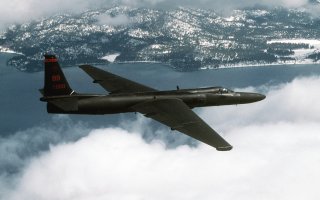The CIA Once Landed Two U-2 Spy Planes on an Aircraft Carrier
The planes were used to spy on France.
Here's What You Need to Know: Several U-2s were modified for carrier operations.
The venerable U-2 spy plane is an old bird. The first U-2s entered service with the United States in 1955 and are still flown today, due to extensive modifications. The large spy planes are easily recognizable thanks to their pencil-like fuselage and delicate looking wings. They are notoriously difficult to land even in favorable conditions—it would be hard to design an airframe less optimized for aircraft carrier landings. But, the CIA thought carrier-capable U-2s were just the thing they needed.
Naval Modifications
Aircraft carriers are floating pieces of American sovereignty, armed to the teeth and answerable only to the President. If a U-2 could be launched and recovered from an aircraft carrier, U-2s could reach most of the globe, without having to negotiate the political complexities of housing spy planes on foreign soil.
Several U-2s were modified for carrier operations. The long slender wings had to be strengthened for harder carrier landings, and spoilers had to be fitted to the back of the wings to help the plane slow down and reduce the required runway landing distance. A hook arrestor had to be fitted to the U-2’s fuselage so the plane could catch the arresting gear as well. Additionally, U-2 pilots had to be retrained for the complex carrier landing maneuvers.
After seven months, the resulting plane was the U-2G. This neat video shows the U-2G landing and taking off from multiple angles. With modifications complete, U-2s were ready to be launched from the sea.
Operation Fish Hawk
France had scheduled several hydrogen bomb nuclear tests on Mururoa Atoll in French Polynesia that the United States wanted to peek in at using the modified U-2Gs. An aircraft carrier, the USS Ranger was tasked with getting two U-2Gs into the vicinity of French Polynesia undetected. The Ranger’s crew was cut to about half, and the U-2s were kept belowdecks out of sight—only essential CIA personnel and some Naval crew were allowed to see the modified spy planes.
In order to prevent the U-2s from being detected, they would have to cruise from approximately 70,000 feet, or about 21,000 meters. At that height, atmospheric conditions had to be favorable for capturing images—clear skies and no cloud cover.
The mission was a success. Skies were clear, and the modified U-2Gs preformed well, snapping photos of the French test site without being detected. They snapped photos of the day of the nuclear test, and afterwards. This was likely one of the only times U-2s were used from aircraft carriers—though we will likely never know for certain due to the secretive nature of the U-2G’s missions.
Caleb Larson holds a Master of Public Policy degree from the Willy Brandt School of Public Policy. He lives in Berlin and writes on U.S. and Russian foreign and defense policy, German politics, and culture.
This article first appeared in May 2020.
Image: Wikimedia Commons

